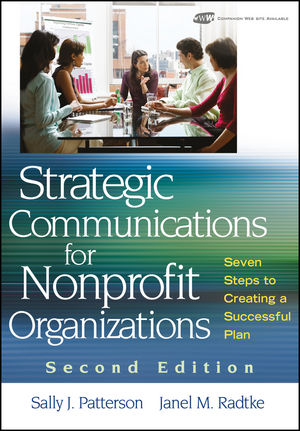Strategic Communications for Nonprofit Organizations: Seven Steps to Creating a Successful Plan, 2nd EditionISBN: 978-0-470-40122-4
Hardcover
288 pages
January 2009
 This is a Print-on-Demand title. It will be printed specifically to fill your order. Please allow an additional 10-15 days delivery time. The book is not returnable.
|
||||||
Preface.
Chapter 1 Getting the Most Out of This Book.
Intended Audiences.
Strategic Communications Plan Framework.
Structure of the Workbook.
How to Use This Workbook.
How to Use the Web Site.
Readiness for Strategic Communications Planning.
Chapter 2 Strategic Communications Planning Process.
Why Strategic Communications Matters.
Benefits of Strategic Communications Planning.
Roles and Responsibilities in Strategic Communications Planning.
Communications Action Team.
Communications Audit Team.
Crisis Communications Planning.
Crisis Communications Team.
Crisis Control Team.
Take the Time, Make the Time.
Chapter 3 Step One: Preparing to Plan: Essential Building Blocks.
Strategic Communications Is Grounded in the Mission.
Task One: Review the Organization’s Mission Statement.
Task Two: Review the Organization’s Program Goals, Objectives, and Financial Priorities.
Communications Audit.
Purpose of the Communications Audit.
Components of a Communications Audit.
Conducting the Communications Audit: Methodology.
Task One: Plan the Audit.
Task Two: Conduct Interviews.
Task Three: Inventory and Analysis.
Task Four: Present Findings.
Task Five: Conduct Additional Research (Optional).
Chapter 4 Step Two: Foundation of the Plan: The Situation Analysis.
Internal Analysis.
Organizational Culture.
Administration.
Programs.
Human Resources.
Infrastructure.
Development.
External Analysis.
Demographic Forces.
Economic Forces.
Political Forces.
Technological Forces.
Social Forces.
SWOT Analysis.
Critical Community Partners and Stakeholders.
Chapter 5 Step Three: Focusing the Plan: Target Audiences.
Understand Your Audience.
Demographic Information.
Geographic Information.
Psychographic Information.
Leadership Potential.
Profile Each Priority Audience.
Research Your Audience.
Media Review.
Readership Surveys or Membership Questionnaires.
Piggyback Surveys.
Exit Interviews or Evaluation Surveys.
Informal Discussions.
Focus Group.
Chapter 6 Step Four: Fostering Audience Support: Communications Objectives.
The SMART Test.
Cycle of the Communications Process.
Create the Communications Objectives.
Communications Objectives: Some Examples Using the Cycle of Communications.
Chapter 7 Step Five: Promoting the Nonprofit Organization: Issue Frames and Message Development.
Define the Key Themes.
Message Frames.
Media Role in Framing.
Episodic and Thematic Frames.
Conducting a Framing Analysis.
Reframing.
Reframing: Underage Drinking.
Message Development.
First Impressions.
Organization Descriptions.
Messages that Resonate.
Building a Message Platform for the Organization.
Chapter 8 Step Six: Advancing the Plan: Vehicles and Dissemination Strategies.
Criteria for Selecting Strategies.
Audience Responsiveness.
The Organization’s Relationship to the Audience.
How the Strategy or Vehicle Will Influence the Audience’s Perceptions.
Controlling the Message.
Effort to Implement.
Budget Issues.
Potential Uses with Other Audiences.
Evaluating Existing and Potential Strategies for Meeting Communications Objectives.
Case Study: Future Generations.
Case Study: Planet 3000.
Strategies and Vehicles to Meet Communications Objectives.
Face-to-Face Meetings.
Print.
Electronic Communications.
Audio Vehicles.
Video.
Web Sites.
Strategic Use of Communications Vehicles.
Alternative Media.
Building a Comprehensive Portfolio of Communications Vehicles to Support the Communications Objectives.
Chapter 9 Step Seven: Ensuring that the Plan Succeeds: Measurement and Evaluation.
Performance Evaluation.
Steps in the Evaluation Process.
Concepts that Have Driven the Strategic Communications Process.
Measuring Success in Achieving Communications Objectives.
Tracking Communications Activities.
Measuring Communications Impact.
Evaluation Tools.
Monitoring the Progress on Communications Objectives.
Finalize the Report.
Chapter 10 Pulling It All Together: Creating the Plan.
Building the Communications Plan.
Putting It All Together.
Creating Organizational Ownership.
Messages to Support the Communications Plan.
Tips for Building Support.
Building the Case for Sustainable Capacity.
Money: If It Is a Good Idea, You Can Sell It.
Income-Producing Possibilities.
In-Kind Contributions.
Strategic Communications Plan Template.
Appendix 1 Planet 3000 Strategic Communications Worksheets.
Appendix 2 Essential Communications Tools.
Appendix 3 Elements of a Style Manual.
Appendix 4 Expanding the Organization’s Coalitions and Partnerships.
List of Worksheets.
Suggested Resources.
Index.



